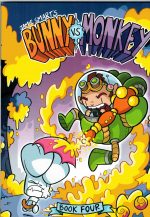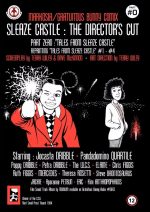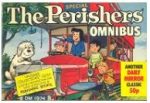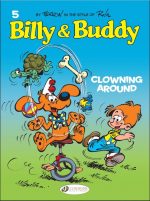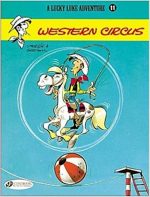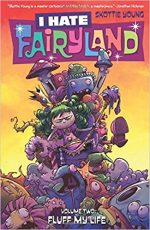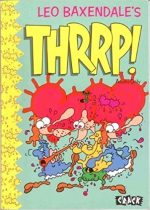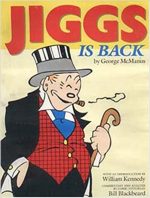
By George McManus (City Lights/Celtic Book Company)
ISBN: 978-0-91366-682-1
Variously entitled Maggie and Jiggs or Bringing Up Father, the comedic magnum opus of George McManus ranks as one of the best and most influential comic strips of all time: a brilliant blend of high satire and low wit that drapes the rags-to-riches American dream with the cautionary admonition to be careful of what you wish for…
Relatively recently this magnificent series was celebrated with a lavish hardcover collection reprinting the strip’s captivating beginnings (see George McManus’s Bringing Up Father: Forever Nuts – Classic Screwball Strips) but that book, wonderful though it is, only prints black and white daily episodes, whilst this colossal softcover from 1986 concentrates on the exceptionally beautiful Sunday colour pages – a perfect proving ground for the artist’s incredible imagination to run wild with slapstick set-pieces, innovative page design and a near-mystical eye for fashion and pattern.
McManus was born on January 23rd in either 1882 or 1883 and drew from a very young age. His father, realising his talent, secured him work in the art department of the St. Louis Republic newspaper.
At thirteen George swept floors, ran errands and drew when ordered to. In an era before cheap, reliable photography, news stories were supplemented by drawn illustrations; usually of disasters, civic events and executions: McManus claimed he had attended 120 hangings (a national record!) but still found time to produce cartoons: honing his mordant wit and visual pacing. His first sale was Elmer and Oliver. He hated it.
The jobbing cartoonist had a legendary stroke of luck in 1903. Acting on a bootblack’s tip he placed a $100 bet on a 30-1 outsider and used his winnings to fund a trip to New York City. The young hopeful splurged his cash reserves but on his last day got two job offers: one from the McClure Syndicate and a lesser bid from Joseph Pulitzer’s New York World.
He took the smaller offer, went to work for Pulitzer and created a host of features for the paper including Snoozer, The Merry Marceline, Ready Money Ladies, Cheerful Charlie, Panhandle Pete, Let George Do It, Nibsy the Newsboy in Funny Fairyland (one of the earliest Little Nemo knock-offs) and, in 1904, his first big hit The Newlyweds.
This last brought him to the attention of Pulitzer’s arch rival William Randolph Hearst who, acting in tried and true manner, lured him away with big money in 1912. In Hearst’s papers, The Newlyweds became the Sunday page feature Their Only Child, and was soon supplemented by Outside the Asylum, The Whole Blooming Family, Spare Ribs and Gravy and, at last, Bringing Up Father.
At first it alternated with other McManus domestic comedies in the same slot, but eventually the artist dropped Oh, It’s Great to be Married!, Oh, It’s Great to Have a Home and Ah Yes! Our Happy Home! as well as his second Sunday strip Love Affairs of a Muttonhead to concentrate on the story of Irish hod-carrier Jiggs whose sudden and vast newfound wealth brought him no joy, whilst his parvenu wife Maggie and inexplicably comely and cultured daughter Nora constantly sought acceptance in “Polite†society.
The strip turned on the simplest of premises: whilst Maggie and Nora perpetually feted wealth and aristocracy, Jiggs – who only wanted to booze and schmooze and eat his beloved corned beef and cabbage – would somehow shoot down their plans; usually with severe personal consequences.
Maggie might have risen in society but she never lost her devastating accuracy with crockery and household appliances…
Bringing Up Father launched on January 12th 1913, originally appearing three times a week, then four and eventually every day. It made McManus two fortunes (the first lost in the 1929 Stock Market crash), spawned a radio show, a movie in 1928, five more between 1946-1950 (as well as an original Finnish film in 1939) and 9 silent animated short features, plus all the assorted marketing paraphernalia that fetches such high prices in today’s antique markets.
McManus died in 1954, and other creators continued the strip until May 28th 2000, its unbroken 87 years making it the second longest running newspaper strip of all time.
McManus said that he got the basic idea from The Rising Generation – a musical comedy he’d seen as a boy, but the premise of wealth not bringing happiness was only the foundation of the strip’s success.
Jigg’s discomfort at his elevated position, his yearnings for the nostalgic days and simple joys of youth are something everyone is prey to. However, the deciding factor and real magic at work here is an entrancing blend of slapstick, social commentary, sexual politics and flashy fashion, all cannily composted together and delivered by a man who lived and breathed comedy timing and could draw like an angel.
The incredibly clean simple lines and the superb use – and implicit understanding – of art nouveau and art deco imagery and Jazz Age philosophy – especially proffered in full colour – make this book a stunning treat for the eye.
This glorious rainbow of mirth includes an introduction from Pulitzer-winning author William Kennedy and an incisive analytical commentary from comics historian Bill Blackbeard for those that need or desire a grounding for their reading, but of course what we all want is to revel in the 48 magnificent, full-page escapades; thoughtfully divided into palatable sections starting with ‘The Joys of Poverty’ from 1923, wherein the family suffered a reversal of fortune and became once more poor, but happy.
This is followed by ‘The Vacation’ (December 9th 1939 to July 7th 1940), a visually spectacular epic following the wealthy-once-more family – complete with new aristocratic English twit son-in-law – on a city-by-city tour of America, and ‘Maggie, Do You Remember When…’ (selected from the peak period of the feature between 1933 and 1942): a shamelessly sentimental and dryly witty occasional series of bucolic recollections of “the good old days†that produced some of the most heart-warming and inventive episodes in the series’ entire history…
An added surprise for a strip of this vintage is the great egalitarianism of it. Although there is an occasional unwholesome visual stereotype to swallow and excuse, what we regard as racism is practically absent. The only thing to watch out for is the genteel sexism and class (un)consciousness, although McManus clearly pitched his tent on the side of the dirty, disenfranchised and downtrodden – as long as he could get a laugh out of it…
This wonderful, evocative celebration of the world’s greatest domestic comedy strip is a little hard to find but well worth the effort. Hopefully some sagacious entrepreneur will eventually get around to giving Bringing Up Father the deluxe reprint treatment it so deserves or at least creating a digital collection for modern-minded old-fashioned comedy mavens to relish and revel in.
© 1986 Celtic Book Company.

